Brant: Heroes in the Underworld
Annotations
Sebastian Brant (1458-1521) was a humanist scholar of many competencies. Trained in classics and law at the University of Basel, Brant later lectured in jurisprudence there and practiced law in his native city of Strasbourg. While his satirical poem Das Narrenschiff won him considerable standing as a writer, his role in the transmission of Virgil to the Renaissance was at least as important. In 1502 he and Strasbourg printer Johannes Grüninger produced a major edition of Virgil’s works, along with Donatus’ Life and the commentaries of Servius, Landino, and Calderini, with more than two hundred woodcut illustrations. (Annabel Patterson)
Properties
Brant: In the Underworld VIII
Annotations
Aeneas and the Sibyl find Anchises talking to a group of shades in the Fields of Elysium (679-83). Anchises hurries toward his son with outstretched arms (684-6). On the left, around the river Lethe [Letheus] are several winged figures, spirits who have been promised second bodies. They drink the water of the Lethe, so that they may begin life in the upper world forgetful of their past life (703-15). The setting is luscious, with flourishing trees and large flowers, to give the sense of abundance and peace associated with the Elysian Fields.
Woodcut illustration from the “Strasbourg Vergil,” edited by Sebastian Brant: Publii Virgilii Maronis Opera cum quinque vulgatis commentariis expolitissimisque figuris atque imaginibus nuper per Sebastianum Brant superadditis (Strasbourg: Johannis Grieninger, 1502), fol. 278v, executed by an anonymous engraver under the direction of Brant.
Sebastian Brant (1458-1521) was a humanist scholar of many competencies. Trained in classics and law at the University of Basel, Brant later lectured in jurisprudence there and practiced law in his native city of Strasbourg. While his satirical poem Das Narrenschiff won him considerable standing as a writer, his role in the transmission of Virgil to the Renaissance was at least as important. In 1502 he and Strasbourg printer Johannes Grüninger produced a major edition of Virgil’s works, along with Donatus’ Life and the commentaries of Servius, Landino, and Calderini, with more than two hundred woodcut illustrations. (Annabel Patterson)
Properties
Brant: In the Underworld VII
Annotations
Aeneas and the Sibyl look upon the Groves of the Fortunate, in Elysium. They watch as, in the center of the image, a pair of men wrestle, a couple dances and another couple sings, reading from a scroll of lyrics (642-4). In the lower left corner, Orpheus plays his lyre (645-7). Next to him, Ilus, grandfather of Priam, Assaracus, grandfather of Anchises, and Dardanus, founder of Troy (Page 499, note 650), stand talking amongst themselves (648-50). In the lower right corner are depicted the arms, carriages, and horses that belong to the shades. The three carriages look a bit odd, like miniature houses on wheels. There are crossbows on the ground next to the carriages, and above the carriages, their spears are propped up against a fence. Their horses, which are supposed to running free and unyoked, are tied to the fencepost of the same fence (651-5). On a small island in the upper corner, a group of shades feast and play music in front of a grove of trees (656-9). The river running around the island is the Eridanus (659). Aeneas and the Sibyl stand talking to Musaeus, a great poet and musician of legend, who directs them toward Anchises (666-78).
Woodcut illustration from the “Strasbourg Vergil,” edited by Sebastian Brant: Publii Virgilii Maronis Opera cum quinque vulgatis commentariis expolitissimisque figuris atque imaginibus nuper per Sebastianum Brant superadditis (Strasbourg: Johannis Grieninger, 1502), fol. 204r, executed by an anonymous engraver under the direction of Brant.
Sebastian Brant (1458-1521) was a humanist scholar of many competencies. Trained in classics and law at the University of Basel, Brant later lectured in jurisprudence there and practiced law in his native city of Strasbourg. While his satirical poem Das Narrenschiff won him considerable standing as a writer, his role in the transmission of Virgil to the Renaissance was at least as important. In 1502 he and Strasbourg printer Johannes Grüninger produced a major edition of Virgil’s works, along with Donatus’ Life and the commentaries of Servius, Landino, and Calderini, with more than two hundred woodcut illustrations. (Annabel Patterson)
Properties
Brant: In the Underworld VI
Annotations
Sebastian Brant (1458-1521) was a humanist scholar of many competencies. Trained in classics and law at the University of Basel, Brant later lectured in jurisprudence there and practiced law in his native city of Strasbourg. While his satirical poem Das Narrenschiff won him considerable standing as a writer, his role in the transmission of Virgil to the Renaissance was at least as important. In 1502 he and Strasbourg printer Johannes Grüninger produced a major edition of Virgil’s works, along with Donatus’ Life and the commentaries of Servius, Landino, and Calderini, with more than two hundred woodcut illustrations. (Annabel Patterson)
Properties
Brant: In the Underworld V
Annotations
Aeneas and the Sibyl reach the Fields of the Warriors. At the top of the image, from right to left, Idaeus, Priam's charioteer (Page 489, note 485), drives his chariot (485); the three sons of Antenor ride in it (483-4). Tydeus, Parthenopaeus and Adrastus stand to their right (479-80). In the lower half of the image, to the right, Agamemnon and some of his warriors are shown running from Aeneas (489-93). Among these warriors, the two most famous members of his army, Ulysses and Menelaus, are present, even though their presence is not mentioned by Vergil and, strictly speaking, anachronistic. In front of Aeneas sits Deiphobus, the second Trojan husband of Helen, disfigured almost beyond recognition. He explains to Aeneas that Helen led Menelaus and his men directly to where he was sleeping and they killed him brutally (494-534). The river Styx flows through the very bottom of the image.
Woodcut illustration from the “Strasbourg Vergil,” edited by Sebastian Brant: Publii Virgilii Maronis Opera cum quinque vulgatis commentariis expolitissimisque figuris atque imaginibus nuper per Sebastianum Brant superadditis (Strasbourg: Johannis Grieninger, 1502), fol. 272r, executed by an anonymous engraver under the direction of Brant.
Sebastian Brant (1458-1521) was a humanist scholar of many competencies. Trained in classics and law at the University of Basel, Brant later lectured in jurisprudence there and practiced law in his native city of Strasbourg. While his satirical poem Das Narrenschiff won him considerable standing as a writer, his role in the transmission of Virgil to the Renaissance was at least as important. In 1502 he and Strasbourg printer Johannes Grüninger produced a major edition of Virgil’s works, along with Donatus’ Life and the commentaries of Servius, Landino, and Calderini, with more than two hundred woodcut illustrations. (Annabel Patterson)
Properties
Brant: In the Underworld IV
Annotations
Sebastian Brant (1458-1521) was a humanist scholar of many competencies. Trained in classics and law at the University of Basel, Brant later lectured in jurisprudence there and practiced law in his native city of Strasbourg. While his satirical poem Das Narrenschiff won him considerable standing as a writer, his role in the transmission of Virgil to the Renaissance was at least as important. In 1502 he and Strasbourg printer Johannes Grüninger produced a major edition of Virgil’s works, along with Donatus’ Life and the commentaries of Servius, Landino, and Calderini, with more than two hundred woodcut illustrations. (Annabel Patterson)
Properties
Brant: In the Underworld III
Annotations
On the left, Aeneas, standing next to the ferry of Charon, shows the golden bough to the ferryman, as proof that he has permission to enter the depths of the underworld; in Vergil, the Sibyl holds the bough (406-10). Charon prepares to ferry Aeneas and the Sibyl across the Styx (407-16). The water is marshy (414-6), which is indicated by the cattails. In the middle of the image the three-headed dog Cerberus growls from its cave, where it guards the entrance to the deeper underworld (417-25). In the upper right, shades are crowded inside the fiery jaws of Hell, which is depicted as a monstrous head. It is interesting to note that the design of the monster is entirely different from the depiction of the same monster in the previous image. On a spit of land between the two primary rivers, more souls sit despairing; these may be the shades whom Charon displaced from his boat in order to carry Aeneas and the Sibyl (411-3).
Woodcut illustration from the “Strasbourg Vergil,” edited by Sebastian Brant: Publii Virgilii Maronis Opera cum quinque vulgatis commentariis expolitissimisque figuris atque imaginibus nuper per Sebastianum Brant superadditis (Strasbourg: Johannis Grieninger, 1502), fol. 268v, executed by an anonymous engraver under the direction of Brant.
Sebastian Brant (1458-1521) was a humanist scholar of many competencies. Trained in classics and law at the University of Basel, Brant later lectured in jurisprudence there and practiced law in his native city of Strasbourg. While his satirical poem Das Narrenschiff won him considerable standing as a writer, his role in the transmission of Virgil to the Renaissance was at least as important. In 1502 he and Strasbourg printer Johannes Grüninger produced a major edition of Virgil’s works, along with Donatus’ Life and the commentaries of Servius, Landino, and Calderini, with more than two hundred woodcut illustrations. (Annabel Patterson)
Properties
Brant: In the Underworld II
Annotations
Aeneas and the Sibyl, in the top right corner, approach the shores of the Cocytus river. The shades of the recently dead pour out from the jaws of a reptilian monster that signifies the entrance to the underworld. The right side of the monster is engulfed in flames. At the top center above and behind the head are two minute figures whose purpose is unclear, but the message seems sinister; a human figure in white is assaulted by a shadowy figure with a tail. Below the monster, a spring pouring out of a rocky cave is the source of the Acheron, Cocytus and Styx rivers (295-7); the latter two are split by a large delta. At the shores of the Cocytus, the river on the right, the shades wait to pass into the deeper realms of the underworld (305-16). In the lower left, Charon, with his garment knotted at his waist instead of his shoulder, ferries a handful of shades across the Styx (298-301). Palinurus, Aeneas' helmsman who fell to his death from the stern of the ship, approaches Aeneas and begs him to return to the shore where his body has washed up and give him a proper burial (337-83). The Sibyl promises him a proper tomb, but not by the men of Aeneas (377-81).
Woodcut illustration from the “Strasbourg Vergil,” edited by Sebastian Brant: Publii Virgilii Maronis Opera cum quinque vulgatis commentariis expolitissimisque figuris atque imaginibus nuper per Sebastianum Brant superadditis (Strasbourg: Johannis Grieninger, 1502), fol. 265v, executed by an anonymous engraver under the direction of Brant.
Sebastian Brant (1458-1521) was a humanist scholar of many competencies. Trained in classics and law at the University of Basel, Brant later lectured in jurisprudence there and practiced law in his native city of Strasbourg. While his satirical poem Das Narrenschiff won him considerable standing as a writer, his role in the transmission of Virgil to the Renaissance was at least as important. In 1502 he and Strasbourg printer Johannes Grüninger produced a major edition of Virgil’s works, along with Donatus’ Life and the commentaries of Servius, Landino, and Calderini, with more than two hundred woodcut illustrations. (Annabel Patterson)
Properties
Brant: In the Underworld I
Annotations
Sebastian Brant (1458-1521) was a humanist scholar of many competencies. Trained in classics and law at the University of Basel, Brant later lectured in jurisprudence there and practiced law in his native city of Strasbourg. While his satirical poem Das Narrenschiff won him considerable standing as a writer, his role in the transmission of Virgil to the Renaissance was at least as important. In 1502 he and Strasbourg printer Johannes Grüninger produced a major edition of Virgil’s works, along with Donatus’ Life and the commentaries of Servius, Landino, and Calderini, with more than two hundred woodcut illustrations. (Annabel Patterson)

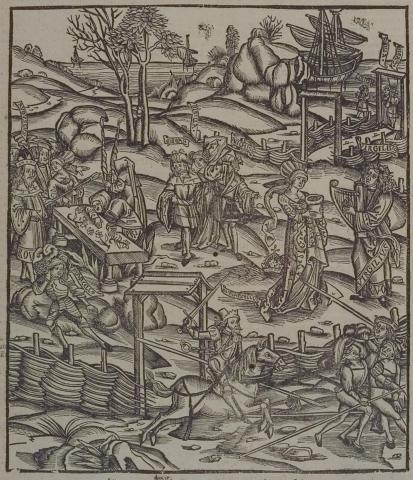
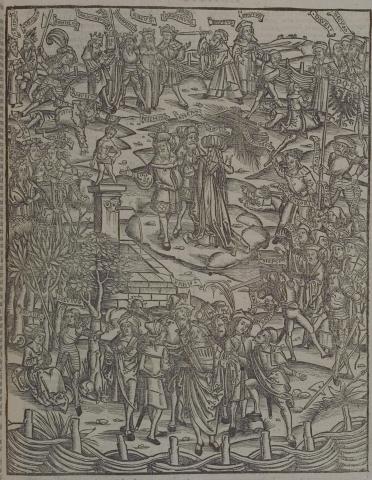
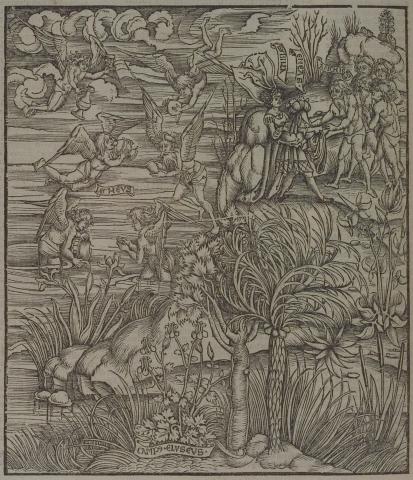
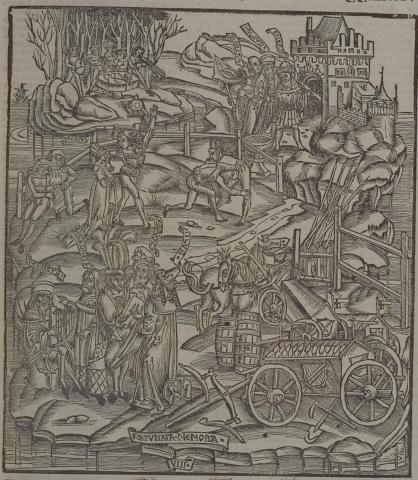
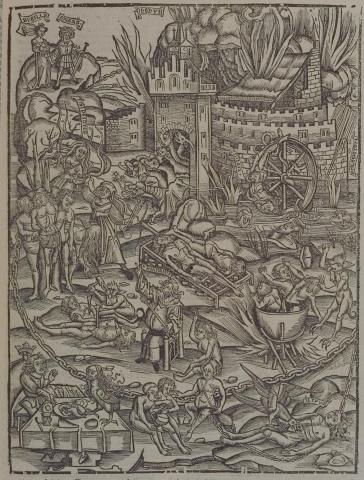
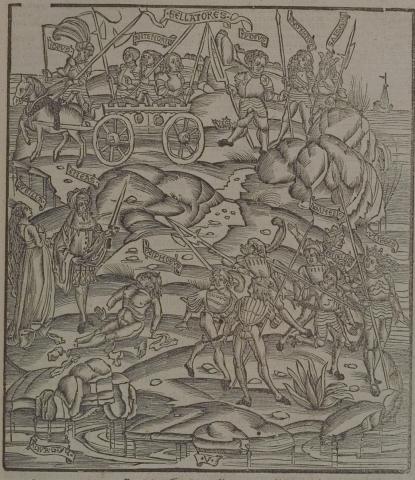
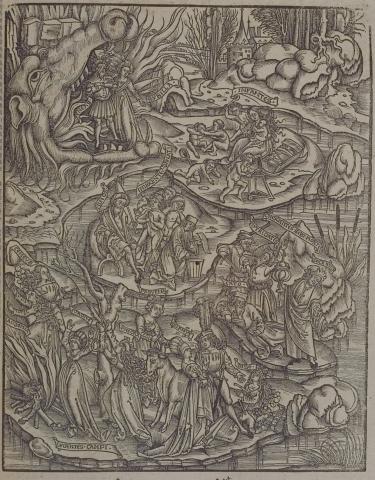
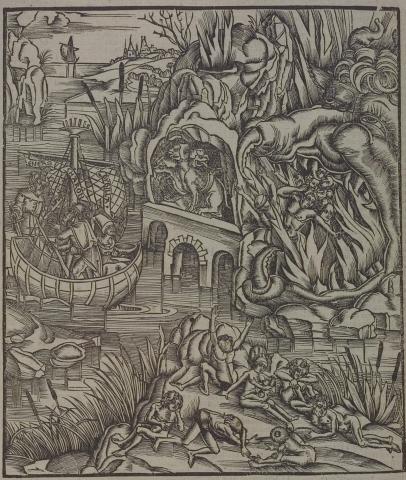
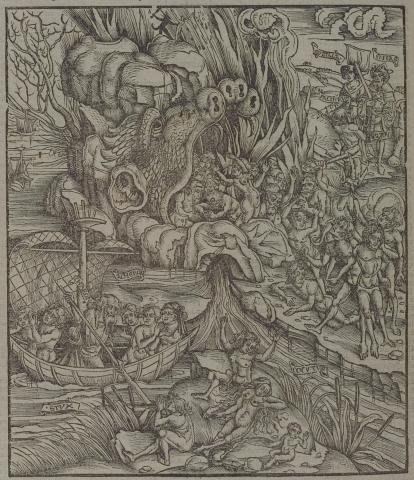

Sebastian Brant (1458-1521) was a humanist scholar of many competencies. Trained in classics and law at the University of Basel, Brant later lectured in jurisprudence there and practiced law in his native city of Strasbourg. While his satirical poem Das Narrenschiff won him considerable standing as a writer, his role in the transmission of Virgil to the Renaissance was at least as important. In 1502 he and Strasbourg printer Johannes Grüninger produced a major edition of Virgil’s works, along with Donatus’ Life and the commentaries of Servius, Landino, and Calderini, with more than two hundred woodcut illustrations. (Annabel Patterson)